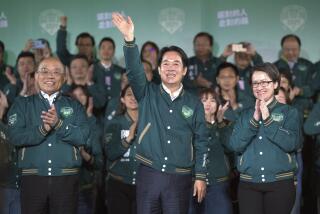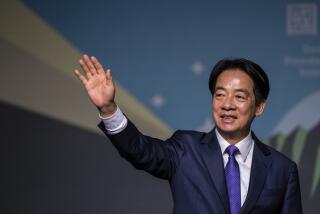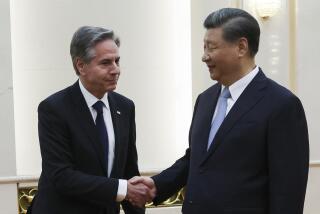Redefining the One-China Policy: Can a Federation Work?
- Share via
MELBOURNE, AUSTRALIA — One achievement no one denies to Mao Tse-tung was that he united China. His socialist schemes may have fallen apart like bean curd turned out of its dish, but he pulled the country together in 1949, after decades of civil war, warlords and foreign intrusion. He persuaded Josef Stalin, and then Richard M. Nixon, to accept that he was the boss of one China.
Each time a flap occurs between Beijing and Washington over Taiwan, the State Department and White House assure Beijing that our one-China policy is unchanged. We did it in the aftermath of Taiwan President Lee Teng-hui’s visit to the United States last year. We do it each time a U.S. official receives the Dalai Lama. We did it this month, when a top Treasury official raised eyebrows by visiting Taipei. Washington has been attached to one China at least since Nixon, in the Shanghai Communique of 1972, acknowledged that “all Chinese on both sides of the Taiwan Strait” upheld one China.
But it may be time for a second look. One China is an ideal, not a reality. Its prospects for realization seem threatened by developments both inside China and beyond. A young, well-connected Chinese said in Beijing recently, “The Chinese Communist party has a choice. It can die by not reforming. Or it can die by reforming.” One scenario for the latter is if Deng Xiaoping’s encouragement of a free market produces a strong middle class that demands competitive politics. Another is if successful economic reform loosens Beijing’s grip on the booming southeast coast and the restive non-Chinese west.
“One country, two systems,” says Beijing of its plans for Taiwan and Hong Kong. Some other parts of China like the idea for themselves, as well.
“Unity” often lies in the eye of the beholder. Chinese called World War I “The European civil war”--from distant Beijing, Europe was seen as one entity. Today, a Westerner visiting Tibet could excused for doubting he was in China. In Singapore or parts of Bangkok, he may think he was in China.
For about half its history, China has had multiple governments. For several lengthy periods, both a southern and a northern regime existed. The Ming Dynasty (14th-17th centuries), the last one of Chinese race, ruled an area about one-third of today’s China. It was Manchu rulers (17th-20th centuries), not Chinese, who expanded this to approximate the size of China. Sun Yat-sen, a hero in both Beijing and Taiwan, was a southern rebel who went north and overthrew a Beijing regime.
The idea of “one China” grips Chinese minds, just as “liberty” grips the minds of the French, and the “American Dream” grips U.S. minds.
The idea of China is like the idea of the British Empire. Both China and the British Empire, as physical entities, grew or shrank over time. Before, during and after India was ruled by Britain, the idea of the British Empire existed. Taiwan, Tibet and other “parts of China” have gone back and forth from rule by Beijing. Often in the Manchu Dynasty, there was “China proper” (zhongguo benbu), ruled by Beijing, and “Outer China” (fanshu), mostly non-Chinese areas like Tibet that had only a loose relation to the emperor in Beijing. Meanwhile, the idea of China endured.
Many of the economic reforms under Deng are the best thing that have happened to the Chinese people since 1949. But reform is a double-edged sword when it comes to the unity of a realm of 1.2 billion people. Deng’s cry, “To get rich is glorious” has united the Chinese around the task of economic development. But the dismantling of the command economy also drains power away from Beijing.
Beijing scratches for revenue. Prosperous southern provinces, laden with investment funds from Taiwan, Hong Kong and Singapore, rake in taxes and fees they are reluctant to share with the bureaucrats of Beijing. The spirit of south China is confident, commercial, oriented to the ocean; north China is wary, political, turned in on the Middle Kingdom.
Deng’s China has pursued economic reform, which the Soviet Union failed to do, but not political reform, which the Soviet Union tackled--and died from. The demise of the Soviet Union suggests the link that exists between autocracy and empire. As Moscow liberalized, its grip on Ukraine, the Baltics and the rest weakened. Deng watched--and learned.
Over the years, the logic of economic reform has repeatedly put political reform on Beijing’s agenda, only to see Deng’s fear of national disunity pull it off. One reason why Deng’s chosen successors, Hu Yaobang and Zhao Ziyang, fell (in 1987 and 1989 respectively) was that they nibbled at political reform.
Today the issues of Hong Kong and Taiwan highlight what a leap of faith one China really is. Several substantial parts of China--including Tibet and the Muslim province of Xinjiang--are not happy under Beijing’s rule. Yet two more parts, also dubious about being ruled from Beijing, are due to go under that rule, or are coveted by Beijing. Hong Kong in nine months. Taiwan when the Beijing military wishes; America turns its back, or Taiwan loses its will to run its own show.
Is a China that has been loosened up by Deng’s reforms destined to expand and successfully embrace Hong Kong, Macao, Taiwan, and other places? It is equally likely that China will, over time, become a bit smaller than it is today.
True, reforms have given China the muscle and national confidence to reach for Hong Kong and Taiwan. Yet the economic dynamism of south China casts new light on the political unity of China. “Greater South China”--that gold coast from Shanghai to Hong Kong and including Taiwan--is an economic phenomenon, but also a political question mark.
The Democrats of Hong Kong are a political danger to Beijing--just as business tycoons of Hong Kong are a seduction. Taiwan’s elected president is a threat, by his very existence, to the Beijing dictatorship; even as Taiwan capital and skills fuel the boom in southeast China.
In the best of all possible worlds, China would evolve toward federalism--and one China might be possible. A federal system would be appropriate for the new society and economy that the Deng era has produced. But a Leninist party, jittery and defensive, rules in Beijing. And a Leninist party is to federalism as a hot sun is to ice cream.
Yet without a structural political expression for the new society and economy of the Deng era, tension will build up and Beijing’s rule will become increasingly brittle.
This is not to suggest that Washington should now renounce acknowledgment of its one-China policy. But the evolution of events is undermining this notion. The premise of the Shanghai Communique--that all Chinese on both sides of the Taiwan Strait uphold one China--is no longer true. A third to a half of Taiwan disagrees. This 7-10 million don’t want reunification with the communist regime in Beijing. Nor do they want a formal declaration of independence. They prefer something in between--which President Lee is giving them. Washington should be agnostic as to where Lee’s leadership takes Taiwan--adamant only that force should not be used in the Taiwan Strait.”
Wang Daohan, the mainland’s chief bargainer with Taipei, reportedly defined China in the following words during a session last year: “China is tantamount to the accumulated history of the Chinese people.” So, perhaps, in due course, Taiwan, the United States, and the world could view China as “today’s leading expression of Chinese civilization . . . “ But not its only expression.
One day there may even exist a League of China-Related Nations, just as the British Empire evolved into a Commonwealth of Nations. Our British friends might seize the opportunity to brief the Chinese on how London came to accept the independent existence of Australia, Canada, New Zealand and other nations that use the English language and build on British institutions. And how London gained, not lost respect for doing so.
More to Read
Sign up for Essential California
The most important California stories and recommendations in your inbox every morning.
You may occasionally receive promotional content from the Los Angeles Times.










